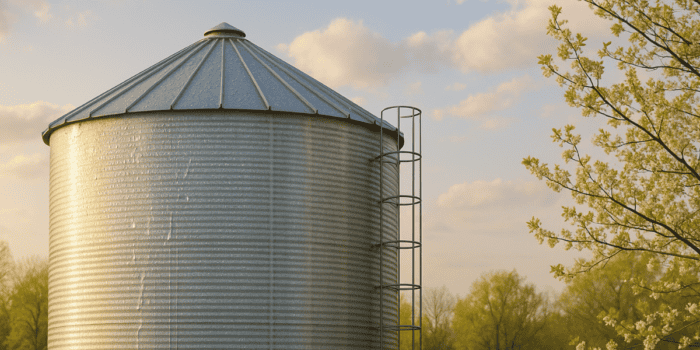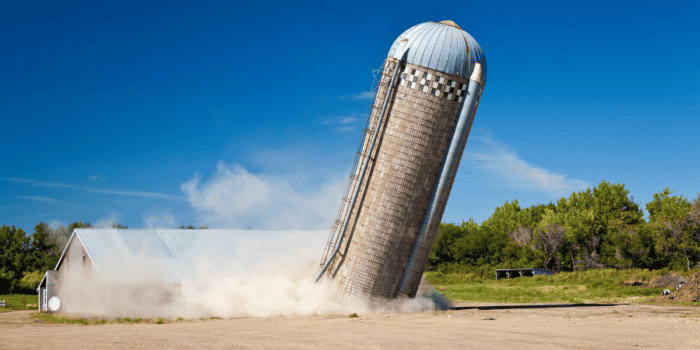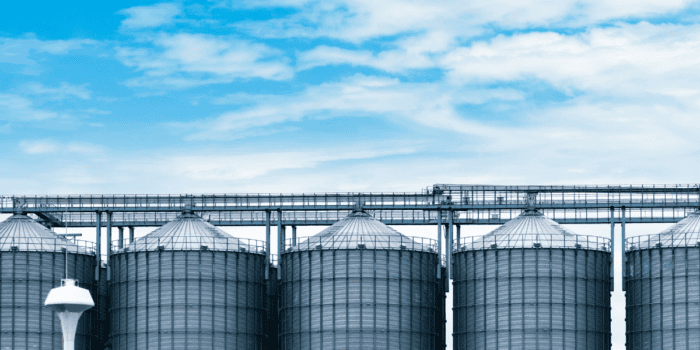
Silo Maintenance 101: Checklists for Year-Round Upkeep
As silo maintenance season ramps up, West Side Salvage sees more service requests than any other time of year—driven by warmer temperatures, moisture migration, and ventilation challenges that can quietly undermine your storage integrity. In this post, we’ll walk you through your essential silo maintenance checklists—covering monthly, seasonal, and annual inspections—so you can keep your facility running safely, protect your grain quality, and avoid costly downtime.
In this guide, we’ll cover the following topics:
- Spring is Peak Season for Silo Maintenance
- What’s at Risk Without Routine Maintenance
- Monthly Silo Maintenance Checklist
- Seasonal Silo Maintenance Checklist
- Annual Maintenance Checklist

Peak Season for Silo Maintenance
Spring’s unique combination of temperature swings, moisture dynamics, and operational timing makes it the busiest season for silo maintenance—and the reasons go well beyond simply “it’s been a while since harvest.”
Dramatic Temperature Swings Trigger Moisture Migration
As outdoor temperatures rise in spring, solar heat warms silo roofs and walls while the grain mass inside remains cold. This temperature differential drives moisture upward and outward, where it condenses on the cooler surfaces—often visible as frost or droplets on vents, hatches, and the underside of roofs. Left unchecked, this moisture migration leads to crusting, mold growth, and spoilage.
Solar Heat Gain Accelerates Spoilage Risk
Spring sunshine delivers more intense solar heat gain on silo surfaces than any other time of year—sometimes more than twice the summer rate on south‑ and west‑facing walls. That extra heat can shorten safe storage time by half or more, as each 10 °F increase in grain temperature dramatically reduces the window before mold and insects become threats.
Post-Harvest and Pre-Planting Timing
With most silos emptied or drawn down after harvest and before the busy planting season, spring is the ideal—and often only—window for thorough inspections, repairs, and cleaning. Operators naturally schedule maintenance now to ensure silos are ready for summer filling or long‑term storage, driving West Side Salvage’s highest call volume of the year.
Takeaway: Quality issues aren’t just cosmetic — they’re costly. Preventing, detecting, and addressing grain damage early is essential for protecting your bottom line.

What’s At Risk Without Routine Maintenance
Regular silo maintenance isn’t just a best practice—it’s the frontline defense against a cascade of potentially catastrophic consequences. Skipping inspections and upkeep can jeopardize your facility’s integrity, your grain quality, and the safety of everyone on site.
Structural Failure and Collapse
Small cracks, corrosion, or weakened seams in silo walls and roofs can progress unnoticed until a catastrophic collapse occurs. Case studies in the chemical processing industry show that weathering and internal corrosion—if not caught early through regular inspections—lead directly to these costly failures.
Grain Spoilage and Quality Loss
Without proper aeration and moisture‐control checks, temperature differentials drive moisture migration that promotes mold growth, crusting, and insect infestations. Aeration strategies proven by USDA research demonstrate that maintaining uniform grain temperatures is essential to prevent these losses. Read our blog on grain damage for more details on this topic.
Fire and Dust-Explosion Hazards
Accumulated grain dust inside and around silos creates a highly combustible environment. OSHA’s grain‐handling regulations (29 CFR 1910.272) detail how dust control and ignition‐source management are critical to preventing devastating fires and explosions in storage facilities.
Entrapment and Suffocation
Flowing grain behaves like quicksand—workers can become engulfed and suffocate in seconds. NIOSH’s landmark alert outlines safe entry procedures and lockout/tagout requirements to prevent these tragic incidents.
Falls, Crushing & Mechanical Injuries
Corroded ladders, deteriorated platforms, and malfunctioning unloading equipment pose serious fall and crushing hazards. OSHA identifies falls from heights and injuries from grain‐handling machinery among the most common life-threatening incidents in the industry.
“The grain handling industry is a high hazard industry where workers can be exposed to numerous serious and life threatening hazards. These hazards include: fires and explosions from grain dust accumulation, suffocation from engulfment and entrapment in grain bins, falls from heights and crushing injuries and amputations from grain handling equipment.”
-OSHA
Common Warning Signs and Potential Outcomes
| Maintenance Neglect Factor | Typical Warning Signs | Potential Emergency Outcome |
|---|---|---|
| Skipped structural inspections | Cracks, corrosion, rust, leaks | Undetected damage leading to collapse |
| Ignoring buildup/removal of material | Blockages, uneven discharge | Overloading, wall rupture, collapse |
| Failure to repair minor damage | Small cracks, loose fasteners | Escalation to major structural failure |
| Neglecting cleaning schedules | Mold, caking, moisture inside | Internal corrosion, contamination, explosion risk |
| Not maintaining safety systems | Broken sensors, alarms, vents | Undetected hazardous conditions, dust explosion, worker injury |
| Lack of foundation checks | Settling, tilting, visible cracks | Foundation failure, total collapse |
Emergency Action Plan Ready
West Side Salvage doesn’t just inspect — we help you prepare. Our Emergency Action Plan service ensures you have a step-by-step rescue and containment protocol in place before disaster strikes.
Takeaway: By prioritizing regular silo maintenance—including visual inspections, seal and vent checks, and dust-control measures—you guard not only your grain’s quality but also the structural integrity of your equipment and the safety of your workforce.
Monthly Silo Maintenance Checklist
Each month, a quick, systematic review of your silos can catch minor issues before they become major headaches. By walking the perimeter, verifying seals and vents, monitoring grain temperatures, and keeping dust and debris under control, you’ll protect your structure, preserve grain quality, and reduce safety risks—all without disrupting your operation. Use the checklist below to guide your team through each essential monthly maintenance task and keep your facility running smoothly year-round.
| Task | Category | Description | Safety Note |
|---|---|---|---|
| Exterior Structural Inspection | DIY-Safe | Walk silo perimeter to spot hairline cracks, corrosion, dents, or loose fasteners. | Wear a hard hat, safety glasses & steel-toe boots; avoid pinch points. |
| Seal & Gasket Check | DIY-Safe | Open/close all hatches, man ways & ports to inspect gaskets for wear, cracking, or displacement. | Use fall-arrest harness when working on roofs (per OSHA 1910.28). |
| Vent & Aeration System Review | DIY-Safe | Clear debris from vents, inlet screens & fan intakes; verify fans run at correct specs. | Lockout/tagout electrical power before servicing fan motors. |
| Grain Temperature Monitoring | DIY-Safe | Probe grain at top, center & bottom; compare to ambient to detect hotspots or moisture buildup. | Stand clear of discharge area when inserting/removing probe. |
| Dust & Debris Removal (External) | Professional Support | Sweep spilled grain and dust around silo base to reduce slip & explosion hazards. | Wear dust mask or respirator if dust levels are high. |
| Corrosion Repair & Structural Reinforcement | Professional Support | Welding, panel, replacement & electrical troubleshooting of aeration fans. | Requires a licensed electrician or industrial ventilation specialist. |
| Fall-Arrest Anchor Installation | Professional Support | Install or re-certify permanent harness anchors; includes pull-testing to OSHA anchor standards. | Must be done by a certified insta;;er to ensure compliance and safety. |
| Internal Dust and Debris Cleaning | Professional Support | Remove fine grain dust inside; requires confined-space protocols and explosion control equipment. | Requires certified grain-handling contractor with HEPA vacuums. |
Get the PDF: Monthly Silo Maintenance Checklist
Best Practices for DIY Safety:
- Train Your Crew: Ensure everyone is OSHA-certified for fall protection and lockout/tagout procedures.
- Use Checklists & Logs: Document each task in a digital log (even a simple spreadsheet) with dates, findings, and photos. This record not only tracks trends over time but also demonstrates due diligence for insurance or regulatory audits.
- PPE Is Non-Negotiable: Hard hats, safety glasses, work gloves, respirators, and harnesses as appropriate.
- Know When to Call Us: If you uncover structural damage, persistent moisture issues, or need confined-space work, West Side Salvage’s experts are ready to step in safely and efficiently.
Takeaway: By handling the straightforward monthly checks in-house and engaging professionals for the higher-risk tasks, you’ll maintain your silos cost-effectively—while keeping your team safe and compliant.
Seasonal Silo Maintenance Checklist (Pre-Harvest & Post-Harvest)
As the seasons change, so do the demands on your silos. Seasonal checks—timed around pre-harvest and post-harvest windows—ensure that shifting temperatures, moisture cycles, and loading schedules don’t compromise your structure or your grain. From inspecting panels and vents to sampling grain for moisture and calibrating aeration systems, these quarterly tasks catch issues that monthly walks might miss and prepare your bins for the year’s busiest periods.
| Task | Category | Description | Safety Note |
|---|---|---|---|
| Shell & Panel Inspection | DIY-Safe | Visually examine walls, joints, seams, and floors for cracks, corrosion, or deformation. | Use hard hat, safety glasses, and gloves; watch for sharp edges and unstable panels. |
| Seal, Gasket & Vent Services | DIY-Safe | Clean and inspect all seals, gaskets, roof vents, and hatch closures; replace worn components. | Use fall-arrest harness when working on roofs; lockout/tagout fan power before vent work. |
| Grain Sampling & Moisture Tracking | DIY-Safe | Collect grain cores at multiple depths; test moisture content to detect seasonal dampness. | Stand clear of discharge areas; wear dust mask if sampling generates fine particulates. |
| Aeration Fan Calibration & Testing | Professional Support | Verify fan RPM, airflow rates, and control sensors; adjust belts, motors and controls. | Requires lockout/tagout and and electrician or HVAC technician to service electrical components. |
| Internal Dust & Debris Cleaning | Professional Support | Remove fine dust from walls, floors, and equipment using explosion-proof vacuums. | Confined-space entry protocols, explosion-inerting, and certified grain-handling contractor. |
Get the PDF: Seasonal Silo Maintenance Checklist
Takeaway: Seasonal checks are your opportunity to catch developing issues tied to changing weather and storage cycles—before they impact your grain quality or silo integrity.
Annual Maintenance Checklist
Once a year, it’s time for a comprehensive, big-picture review of your silo’s health. Annual inspections go beyond routine upkeep to include structural engineering assessments, foundation settlement surveys, load-limit analyses, and a full replacement of seals and gaskets. Pairing these in-depth checks with a live emergency-response drill and a safety-equipment audit guarantees that both your silos and your team are ready to perform safely and reliably for another year.
| Task | Category | Description | Safety Note |
|---|---|---|---|
| Third-Party Structural & Engineering Review | Professional Support | Engage a qualified engineer to inspect silo shell, roof, and foundations; perform non-destructive testing (NDT). | Confined-space protocols; certified inspector with NDT equipment. |
| Foundation Settlement Survey | Professional Support | Survey slab and footing for differential settlement or heave; check anchor bolt torque and plate alignment. | Use calibrated surveying tools; wear steel-toe boots and hard hat around heavy equipment. |
| Load-Limit & Stress Analysis | Professional Support | Verify current load ratings; assess flange, seam, and panel stresses under peak fill conditions. | Requires certified structural engineer and load-test instrumentation. |
| Complete Seal & Gasket Replacement | Professional Support | Remove all old seals/gaskets (hatches, man ways, access ports) and install new OEM-spec components. | Use fall-arrest harness when working at height; inspect replacement parts before fitting. |
| Sensor & Control System Calibration | Professional Support | Test and recalibrate temperature probes, bin-full sensors, aeration controls, and alarm systems. | Lockout/tagout electrical power; performed by a licensed electrician or instrument tech. |
| Full Interior Cleaning & Sanitation | Professional Support | Deep-clean walls, floors, and equipment with HEPA-filtered vacuums and NSF-approved sanitizers. | Confined-space entry, explosion-inerting, and certified grain-handling contractor. |
| Safety Equipment Audit | DIY-Safe | Visually inspect fall-arrest anchors, rescue tripods, and lifeline harnesses; check manuals and inspection tags. | Wear gloves and eye protection; follow manufacturer’s visual inspection guidelines. |
| Emergency Response Drill | DIY-Safe | Conduct a live drill of your silo-entry and rescue procedures with your team; record outcomes and improvements. | Ensure everyone wears full PPE; have an external rescue team on standby. |
Get the PDF: Annual Silo Maintenance Checklist
Takeaway: Your annual silo inspection is the cornerstone of a proactive maintenance program—catching structural, foundation, and system issues before they become emergencies.

Conclusion
By tackling these routine checks—monthly, seasonal, and annual—you’ll keep your silos in peak condition, protect your grain quality, and safeguard your team from preventable hazards.
But you don’t have to do it alone. West Side Salvage offers comprehensive silo services, from detailed condition assessments and confined‑space cleaning to structural repairs and aeration system tune‑ups. Our experts use industry‑leading equipment and decades of hands‑on experience to identify issues early, execute repairs safely, and help you implement a maintenance program that minimizes downtime and maximizes storage life.
Ready to take the guesswork out of silo upkeep? Contact West Side Salvage today to schedule your spring inspection or learn more about our tailored maintenance solutions.
References
- Purdue University Extension. Aeration for Safe Grain Storage (AED-20). https://www.extension.purdue.edu/extmedia/aed/aed-20.html
- University of Minnesota Extension. Managing Stored Grain with Aeration. https://extension.umn.edu/corn-harvest/managing-stored-grain-aeration
- North Dakota State University Extension. “Proper Grain Monitoring and Storage Remain Critical in Springtime.” https://www.ag.ndsu.edu/news/newsreleases/2025/april/proper-grain-monitoring-and-storage-remain-critical-in-springtime
- Occupational Safety and Health Administration. Grain Handling Standard (29 CFR 1910.272). https://www.osha.gov/laws-regs/regulations/standardnumber/1910/1910.272
- Occupational Safety and Health Administration. Fall Protection (Construction) Standard (29 CFR 1910.28). https://www.osha.gov/laws-regs/regulations/standardnumber/1910/1910.28
- National Institute for Occupational Safety and Health. Preventing Entrapment and Suffocation Caused by Unstable Stored Materials (NIOSH Doc 88-102). https://www.cdc.gov/niosh/docs/88-102/default.html
- Occupational Safety and Health Administration. Grain Handling Overview. https://www.osha.gov/grain-handling